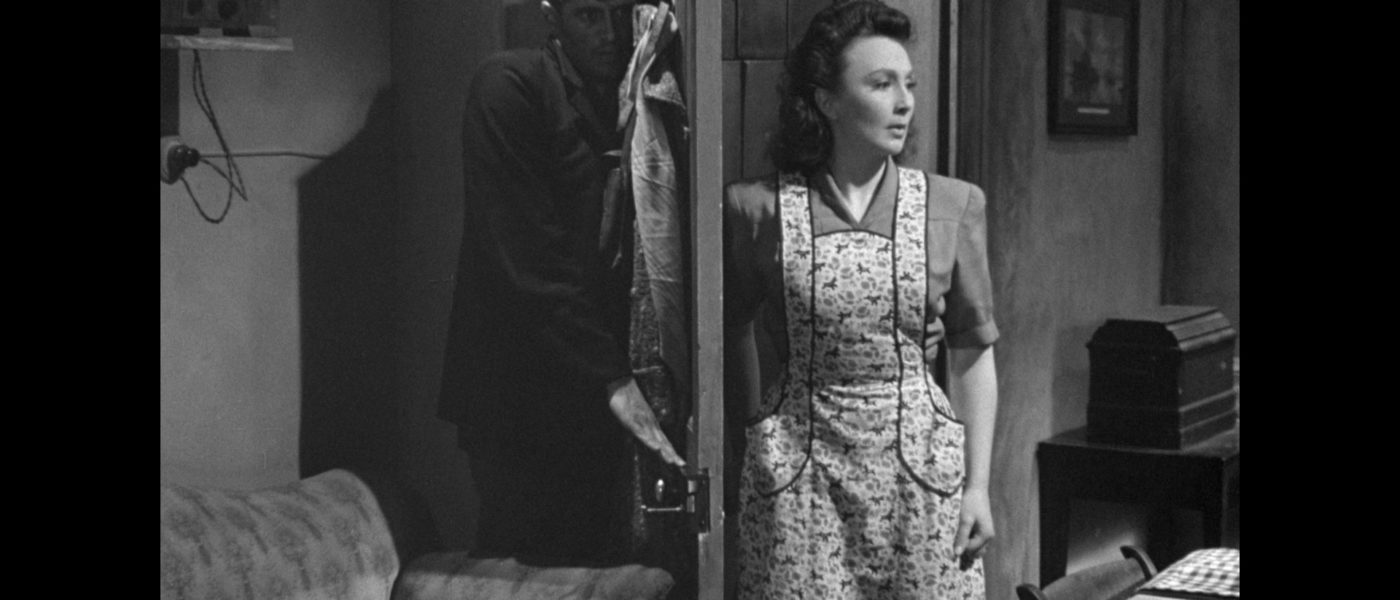Visually Poetic And Atmospherically Dreary Portrait Of Postwar Cockney Neighborhood

1948/DIRECTED BY ROBERT HAMER
STREET DATE: November 5th, 2019/KINO LORBER STUDIO CLASSICS
Bethnal Green, the historical East End London district featured on a drizzly weekend seventy-one years ago, is atmospherically drenched in the title element for 92 minutes of poetically deglamorized, slice-of-life melodrama. From an open street market to a shady business arcade, and down slickened cobblestone streets passing through shadowy bridge-tunnels, the train tracks that open and end the film may lead to exotic parts unknown, but their crisscrossing confusion offer little more than a temporary escape from the stark everyday. A stylish sport and his philandering musical brother, a trio of would-be crooks and their church organ-playing fence, a still-young female head-of-household at odds with her teenage step-daughters, and finally an escaped convict hiding in a garden air-raid shelter; the Bethnal Green denizens inhabiting this desaturated romantic milieu prove, and indeed live, the consistently understated irony of the oft-observed Cockney axiom that It Always Rains on Sunday.
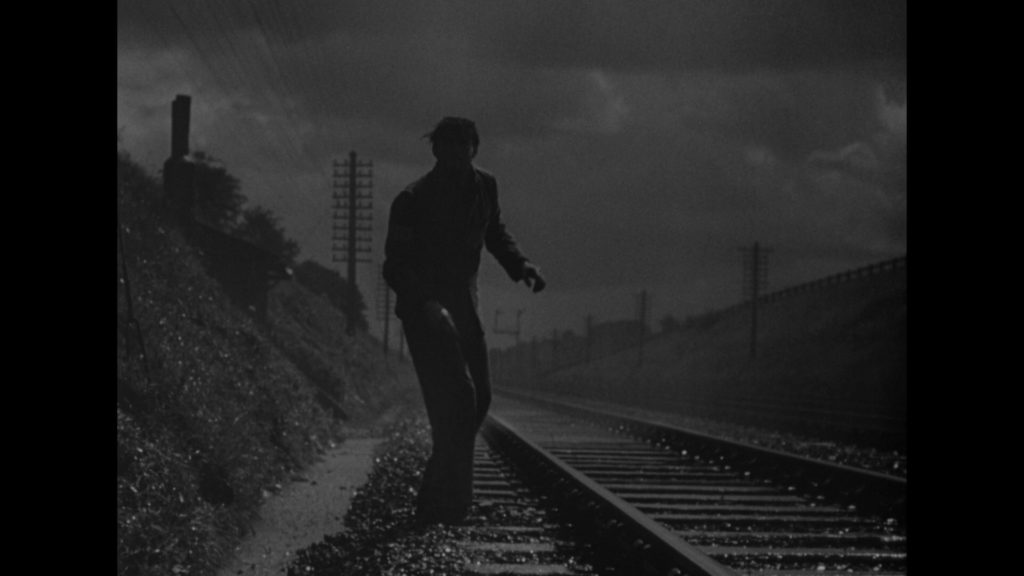
Tying evocative location and its historical moment to indelible character(s), the film opens with prewar criminal and interim prisoner Tommy Swann (John McCallum) emerging illegally onto the postwar scene of his former neighborhood. Stumbling over the grimy steel rails that point to either freedom or recapture, news of the notorious outlaw — by print or hearsay — variously reaches the varying local dramas autumnally lighting the damp dawn of a dreary sabbath.
Raindrop dodgers on this less-than-pleasant Bethnal Green morning, afternoon, and evening include trench coats-clad Whitey, Freddy, and Dicey (Jimmy Hanley, John Carol, Alfie Bass), haunting street vendors and back alleys on one end of the law, unsuccessfully unloading a pathetic haul of roller skates — landing ultimately on psalm-singer and parsimonious receiver-of-stolen goods Caleb Neesley (John Salew) — and Detective Inspector Fothergill (Jack Warner) raiding flophouses and backroom pubs on the other, in dogged pursuit of the day and area’s most infamous native son. Among those others for whom this rainy Sunday is furthest from a day of rest: slick entrepreneur Lou Hyams (John Slater) skillfully works the burgeoning black market as his more legitimate businessman brother Morry (Sydney Tafler) plays saxophone by night, sells sheet music by day, and pursues young ladies outside his marriage by twilight.
Finally, the Sandigate household, headed nominally by middle-aged paterfamilias George (Edward Sandigate) but pragmatically run by his much-younger wife Rose (Googie Withers) —who also daily battles step-daughters near-in-age in the vain Vi (Susan Shaw) and plaintive Doris (Patricia Plunkett) — becomes the unlikely center of the as-yet unremarkable day’s yet-unknown drama when Tommy Swann chooses the Sandigate’s garden shed for a hiding place. In a practically former life, Tommy, then a gangster, and Rose, then a barmaid, had been lovers, and Tommy’s rainy Sunday concealment in, successively, the family kitchen, the couple’s bedroom, and finally the marital bed — with daily life transpiring unabated (and unbeknownst) on the reflecting streets below — builds to the very moment of inevitable discovery, followed quickly by dramatic pursuit and uneasy resolution.
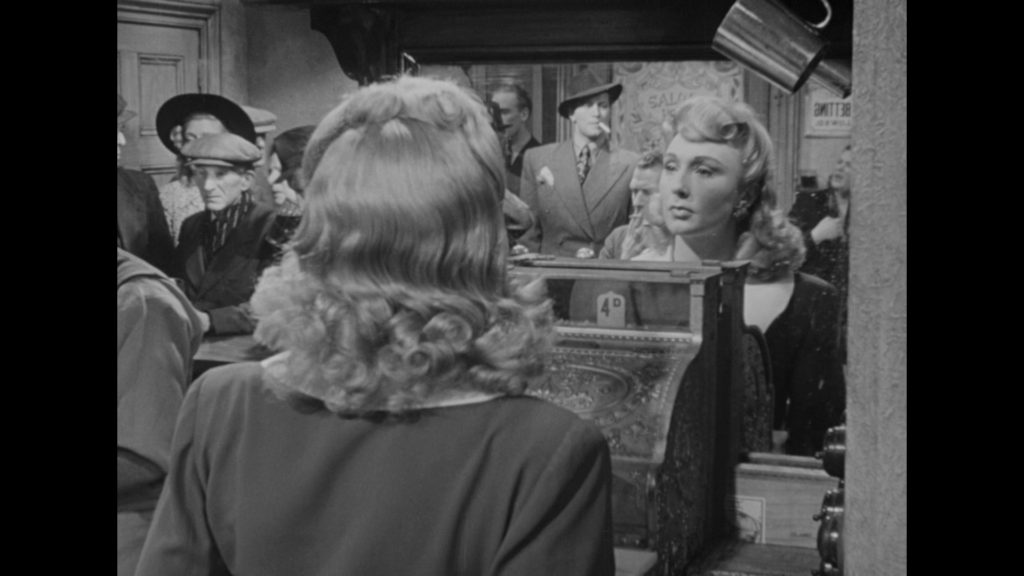
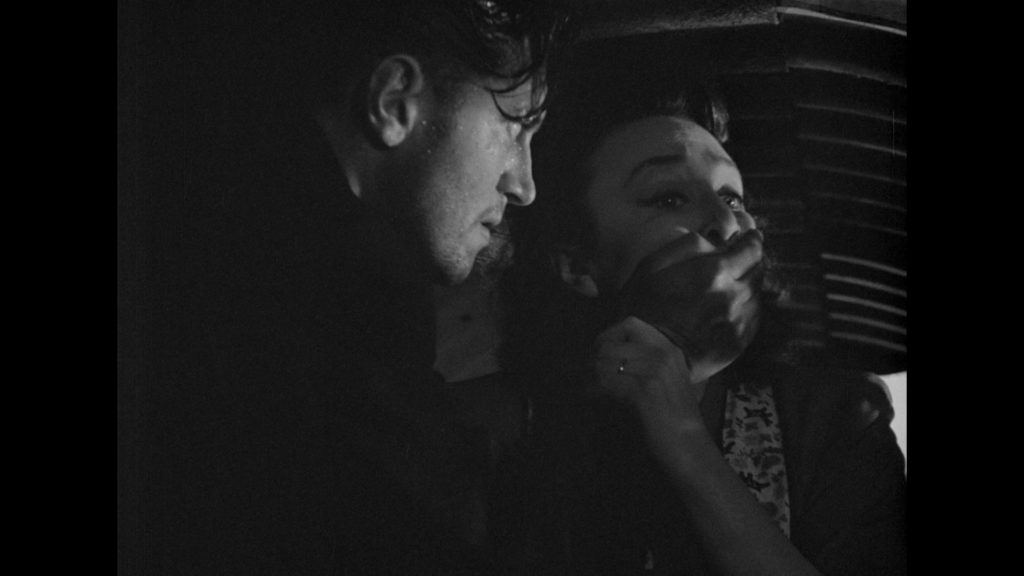
The multi-character, single-location canvas of talented director Robert Hamer, who would follow up with his 1949 masterpiece Kind Hearts and Coronets, also made at Britain’s sterling Ealing Studios, allows an entire spectrum of dramatic moods and emotional textures throughout, ranging visually poetic from the understated comment of blackout tar over a broken window pane to the inelegant chintzy décor of a dour nightspot. Photographed by the versatile Douglas Slocombe, the drab lighting of the Sandigate kitchen recedes to the somber dirgetones of the film’s exciting (and indeed terrifying) railyard climax; in between, the shops, markets, arcades, over- and underpasses — along with the shaded interiors saving on the electricity bill, presumably — once again give as vivid an impression of 1947 working-class England as any primary historical source.
Unusual in the annals of both contemporary British film and its equally crisscrossing intersection of international genres — women’s picture, social realism, poetic drama, and film noir — It Always Rains on Sunday is most astonishing for its apparent verisimilitude to time and place. Viewers in late 2019 (and across an ocean, to boot) may be hard-pressed to spot the subtle sociological details into postwar Cockney London life, yet, among much else, the dull routine of a domestic drudge’s daily chores, the irreverent whine of grating harmonica-playing trailing carefree children on the sabbath, the casual attitudes displayed by ethnic minorities (the Hyams) and social bigots (the Neesleys) alike all create as complete a fimic world far exceeding the most rigorously researched historical reenactment.
Because, of course, It Always Rains on Sunday feels never less than the absolute real deal. When the most disgruntled among three thieves vows vengeance on his hypocritical reseller, the resulting sequence of the latter bald, mild-mannered church-goer’s false teeth spilling onto a dark alley puddle as the crook rifles through his pockets — only for notorious escapee Tommy Swann to ride up on a bicycle and third-party “relieve” the head-masher of his just-spoiled spoils — is a brilliant accumulation of bizarre details that not only sequentially ties together several converging storylines but also thematically underlines the desperate and disparate layers of urban malaise from the literal bottom-up. (Which, earlier in the film, as Inspector Fothergill hunts for Tommy in a flea-ridden dross-house, esteemed character actress Hermione Baddeley, in a small but memorable role as the bunk-joint’s bathrobed landlady, even more directly — and naturally — illustrates with a hilariously timed ass-scratch.)
Although little (or more accurately under-)known outside of the U.K., and overshadowed even in its country of origin by several contemporary comedies and farces simultaneously produced at the iconic Ealing Studios, It Always Rains on Sunday is again unique among the upper-class fantasy-view of postwar British life that characterized the vast majority of Britain’s domestic filmed output during the late 1940’s and early 1950’s. The coin-slotted heater-grilles, narrow sideboards, and flickering gas ovens — along with the shoulder-strapped, floral-patterned aprons and the starch-set hair waves — were undoubtedly more keenly regonizable if less pleasantly resonant with many female viewers of the time than, say, the brittle though enjoyable wisecracks of their social betters echoing through streamlined Art Deco mausoleums. (Or “luxury flats”, one should more properly say.) Possibly their contemporary recognition offered little escape from the stultifying realities of the day that a trip to the cinema might have usually afforded — which could explain why the film was less successful in its time with working-class audiences — but today offers a fascinating dramatic view of a now remote time and place.
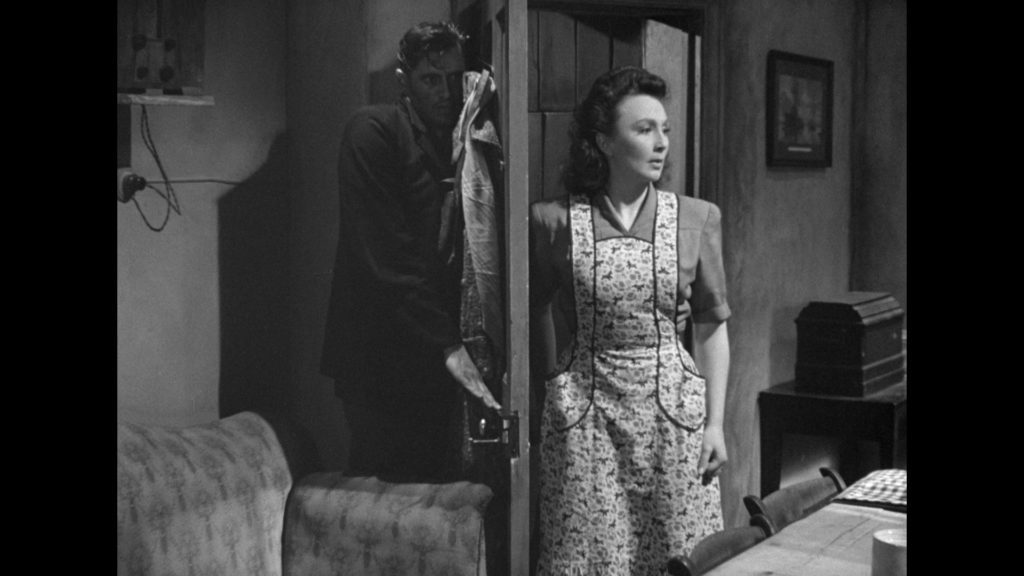
Contextualizing the film further, Kino Lorber offers a gallery of special edition features which include a talking-heads documentary, a brief filmed guide to Sunday’s past-and-present locations, and an informative feature-length commentary:
The first documentary, entitled Coming in from the Rain, produced for an earlier British release of the film on Blu-ray, features interviews with such lauded latterday appreciators of the film as writer and documentarist Iain Sinclair, producer Sean O’Connor, and feature-film director Terence Davies. (The latter pair of whom had collaborated on the celebrated 2011 adaptation of the 1952 Terence Rattigan play The Deep Blue Sea, which for its overlapping period and setting would make a fascinating double-bill with It Always Rains on Sunday.)
Film historian Richard Dacre provides a well-researched featurette to the film’s Locations, showing how the many exteriors around London’s East End were skillfully tied to interior and seemingly open-aired sets — one of which seamlessly recreated a bustling Bethnal Green street market.
Imogen Sara Smith matches the film’s level of drama and detail with yet another wonderfully articulated, deeply researched, and strongly analytic discussion track. Whether on the uniquely British iteration of film noir, its unusually opposing character conceit of the homme fatale, or actress Googie Withers’ curtain call on her long association with Ealing Studios, and her coming sixty-year marriage to first-time co-star John McCallum, an Imogen Sara Smith commentary is never less than absorbing.
…
Finally, the belated discovery of It Always Rains on Sunday may impress on a first viewing with its bravura climactic chase through the aforementioned railyard — which interviewee Terence Davies justly compares to the best in production value to Hollywood features of the time — but ultimately Sunday lingers more appreciatively on the viewing palette with its subtle and sensitive attention to poetic detail. An engagement ring stored at the bottom of a dresser drawer offered on a visit to the countryside long ago and then given back a full decade later — forgotten by its original giver and uncommented upon by its original recipient — is but one of the realistically-drawn and truly heartbreaking moments of expressive honesty to which worldclass filmmaking aspires. Time, place, and setting reach across the years and make this damp and dreary day of uneasy rest our own.
Images are credited to DVDBeaver and are taken from Kino Lorber’s Blu-ray. Thanks to Kino Lorber for providing a review copy.


